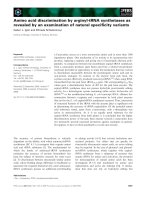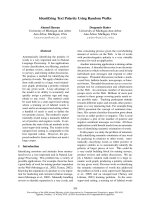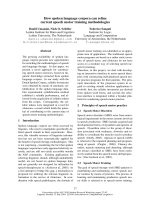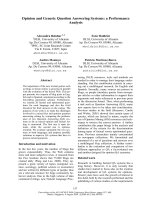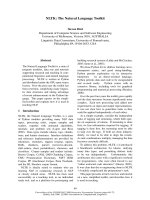Tài liệu Báo cáo khoa học: "Domain-Independent Natural Language Database Access Systems" pptx
Bạn đang xem bản rút gọn của tài liệu. Xem và tải ngay bản đầy đủ của tài liệu tại đây (251.67 KB, 3 trang )
Problems ¥ith Domain-Independent Natural Language Database Access Systems
Steven P. Shvartz
Cognitive Systems Inc.
234 Church Street
New Haven, Ca.
06510
Zn the past decade, a number of natural lang-
uage database access systems have been constructed
(e.g. Hendrix 1976; Waltz et el. 1976; Sac-
erdoti 1978; Harris 1979; Lehner~ and Shwartz
1982; Shvartz 1982). The level of performance
achieved by natural language database access sys-
tems varies considerably, with the sore robust
systems operating vithtn a narrow domain (i.e.,
content area) and relying heavily on domain-speci-
fic knowledge to guide the language understanding
process. Transporting a system constructed for one
domain into a new domain is extremely resource-in-
tensive because a new set of domain-specific know-
ledge must be encoded.
In
order to reduce the cost of transportation,
a great deal of current research has focussed on
building natural language access systems that are
domain-independent. More specifically, these sys-
tems attempt to use syntactic knowledge in con-
~unction with knowledge about the structure of the
database as a substitute for conceptual knowledge
regarding the database content area. In this paper
I examine the issue of whether or not it is possi-
ble to build a natural language database access
systee that achieves an acceptable level of per-
formance without including domain-specific concep-
tual knowledge.
6 gerforn=nca
~i~g~ion for
oa~u£al language atoms=
=X=~em=,
The principle motivation for building natural
language systems for database access is ~o free the
user from the need for data processing instruction.
A natural language front end is a step above the
"English-like = query systems that presently domi-
nate the commercial database retrieval field.
English-like query systems allow the user to phrase
requests as English sentences, but permit only a
restricted subset of English and impose
a
rigid
syntax on user requests. These English-like query
systems are easy to learn, but a training period is
still required for the user to learn to phrase re-
quests that conform to ~hc~ restrictions. Howe-
ver, the training period is often very brief, and
natura~ language systems can be considered superior
only if no computer-related training or knowledge
is required of the user.
This criterion can only be met if no restric-
tions are placed on user queries. A user who has
previously relied on a programmer-technician to
code formal queries for information retrieval
should be permitted to phrase inform%ion retrieval
requests t~ the program in exactly the same way as
to the technician. That is, whatever the techni-
cian would understand, the program should
understand. For example, a natural language front
end to a stock market database should understand
that
(1) Did IBM go up yesterday?
refers to PRZCE and not VOLUME. However, the sys-
tem need not understand requests that a program-
mer-technician would be unable to process, e.g.
(2) Is GENCO a likely takeover target?
That
is, the programmer-technlcisn uorking
for an
investment firm would not be expected to know how
t<) process requests that require "expert" knowledge
and neither should | natural language front end,
If, however, = natural language system cannot a-
chieve the level of performance of a program-
ear-technician it will seem stupid because it does
not meet = user's expectations for an English un-
derstanding system,
The mprograemer-technician criterion m cannot
possibly be met by = domain-independent natural
language access
system
because language understan-
ding requires domain-specific world knowledge. On
a theoretical level, the need for a knowledge base
in a natural language processing system has been
well-documented (e.g. Schank A Abelson 1977;
Lehnert 1978; Dyer 1982). It will be argued
below that in an applied context, a
system
that
does not have a conceptual knowledge base can pro-
duce at best only a shallow level of understanding
and one that does not meet the criterion specifled
above. Further, the domain-independent approach
creates a host of problems that are simply non-ex-
istent in knowledge-based s~stems.
E~oble== far dolai0:i0dg~a0dan~ =~=~®=~ infer-
ence.
ambiguity,
sod aoagbora,
Inferential processing is an integral part of
natural language understanding. Consider the fol-
lowing requests from PEARL (Lehnert and Shvartz
1982; Shwartz 1982) when it operates in the domain
of geological map generation:
60
(3) Show ss ell oil veils from 1970 to 1980.
(4) Show Is all oil veils fro! 8000 ~ 7000.
(5) Show se all oil wells 1 t~a 2000.
(6) Show ee all oil wells 40 to 41, 80 to 81.
A
programmer-technician
In
the petrochemical in-
dustry would infer that (3) refers to drilling
dates, (4) refers ~o veil depth, (5) refers ~o the
sap scale, end (6) refers to latitude/longitude
specifications.
Correct processing of these requsst~ requires in-
ferential processing that is based on knowledge of
the petrochemical industry. That is, these con-
ventions =re not in everyone's general working
knowledge of the English language. Yet they are
standard usage for people who communicate with each
other about drilling data, and any systss that
claims t~o provide a natural language interface t~ l
data base of drilling data must have the knowledge
to correctly process requests such as these.
Without such inferential processing, the user is
required to spell out everything in detail, some-
thing that is sispty not necessary in normal Eng-
lish discourse.
Another probles for any natural language un-
derstanding systes is the processing of ambiguous
words. In some cases disambiguation can be per-
formed syntactically. In other cases, the struc-
ture of the database can provide the information
necessary for word sense disambiguation (more on
this below). However, in many cases disasbiguation
can only be performed if domain-specific, world
knowledge is available. For example, consider the
processing of the word "sales = in (7), (8) and (9).
(7) What is the average mark up for sales of stereo
equipment?
(8) What is the average mark down for sales of
stereo equipment?
(9) What is the average mark up during sales of
stereo equipment?
(10) What is the average mark down durlng sales of
stereo equipment?
These four requests, which are so nelrly identical
both lexically and syntactically, have very dis-
tinct meanings that derive from the fact that the
correct sense of 'sliest in (7) ls quits different
from the sense of "sales = intended in (8), (9), end
(10). Nest people have little difficulty deter-
mining which sense of =sales = is intended in these
sentences, and neither would
a
knowledge-based un-
derstander. The key to the disambiguation process
involves world knowledge regarding retail sales.
Problems of anaphora pose similar problems.
For example, suppose the following requests were
submitted to a personnel data base:
(11) List all salesmen with retirement plans along
with their salaries.
(12) List all offices with women managers along
with their salaries.
While these requests are syntactically identical,
the referents for "their" in (11)
end
(12) occupy
different syntactic positions. As human informa-
tion processors, ve have no trouble understanding
61
that salarie~ are associated with people, so
retirement pllns and offices are never considered
as possible referents. Again, domain-specific
world knouledge is helpful in understanding these
requests.
~Ug~u~al
knQwlldgm
i=
m
=uh=~i~u~m fo~
GQO¢ID~ual
knowlsdgg,
One of inner|aliens to
eaerge
from the con-
struction of domain-independent systems is
t
clever
mechanism that extracts dosain-speclflc knowledge
free the structure of the
data
base. For example,
the resolution of the pronoun 'their = in both (11)
and (12) above could be accomplished by using only
structural (rather than conceptual) knowledge of
the domain. For example, suppose the payroll
database for (11) were structured such that SALARY
and RETIRENENT-PLANS were fields within a SALESMAN
file. It would then be possible to infer that
ltheir= refers to =salesmen = in (11) by noting that
SALARY is a field in the SALESMEN file, but that
SALARY is not an entry in I RETIREMENT-PLANS file.
Unfortunately, this approach has lilited u-
tility because it relies on a fortuitous de,abase
structure. Consider what would happen if the data
base had a top-level ERPLOYEES file (rather than
individual files for each type of employee) with
fields for JOB-TYPE, SALARY, COMMISSIONS,
and
RE-
TZRENENT-PLANS, With this database organization,
it would not he possible to detersine that
(13) List all salesmen who have secrebaries along
with their comsissions.
ltheir= refers ~o meal=amen" and not "secretaries =
in (13) on the basis of the structure of the data-
bass. To the naive user, however, the seining of
this sentence is perfectly clear. A person who
couldn't determine the referent of "their = in (13)
would not be perceived as having an adequate cos-
sand of the English language and the same would be
true for a computer system that did not understand
the request.
~i~fall= a==g~il~Id wi~b ~bm dQ®zin:indag~ndln~
i~-
In a knowledge-based systes such as PEARL, =
natural language request is parsed into a concep-
tual representation of the meaning of the request.
The retrieval routine is then generated free this
concepbual representation. As a result, the parser
is independent of the logical structure of the
database. That is, the same parser can be used for
databases with different logical structures, but
the same information content. Further, the same
parser can be used whether the required information
is located in = single file or in lultiple files.
In a domaln-independent systes, the parser is
entirely dependent on the structure of the database
for domain-specific knowledge. As a result, one
must restructure the parser for databases with i-
dentical content but different logical structure.
Sisilarly, the output of the parser lust be very
dlfferent vhen the required information Is con-
tained in mulSiple files rather than a single file.
Because of their lack of conceptual knowledge
regarding the database, domain-independent systems
rely heavily on key words or phrases to indicate
which database field iS being referred to. For
example,
(14) Vhat is Bill Smith's ~ob &male?
High& be easily processed by simply retrieving the
con&ants of a JOB-TITLE field. Different vlys of
referring ~o job title can also be handled as syn-
onyms. However, dosiin°independent systems get
into deep trouble vhen the database field that
needs to be accessed is not directly indicated by
key words or phrases in the input request. For
example,
(15) Is John Jones the child of an alumnus?
is easily processed if there exists a
CHILD-OF-AN-ALUMNUS field, but the query
(16) Is one of John Jones' paren&s an alumnus?
contains no key word or phrase to indicate that the
CHILD-OF-AN-ALURNUS field should be accessed, In a
knowledge-based system, the retrieval routine is
generated from a conceptual representation of the
meaning of the user query and therefore key words
or phrases arm not required. A related problem
occurs with queries involving a~reption or quan-
tity. For example,
(17) How many employees are in the sales depart-
ment?
light require retrieving the value of a particular
field (e.g. NUHBER-OF-EHPLOYEES), or it sight re-
quire totalling the number of records in the EH-
PLOYEE file that have the correct DEPARTNENT field
value, or, if the departments are broken down into
offices, it light require totalling the NUN-
BER-OF-ENPLOYEES field for each office. In m do-
main-independent system, the correct parse depends
upon the structure of the database and is therefore
difficult to handle in a general way. In a know-
ledge-based system such as PEARL, the different
database structures would simply require altering
the mapping between the conceptual representaSion
of the parse and the retrieval query.
Finally, this reliance on database structure
can lead to wrong answers. A classic example is
Harris' (1979) 'snowmobile problem =. Yhen Harris'
ROBOT system interfaces with a file containing in-
formation about homeowner's insurance, the word
'snowmobile" is defined as any number • 0 in the
'snowmobile field" of an insurance policy record.
This means that as far as ROBOT is concerned, the
question 'How many snowmobiles are there? = is no
different from "How many policies have snowmobile
coverage?" However, the correct answers to the two
questions will often be very different. If the
first question is asked and the second question is
answered, the result is an incorrect answer. If
the first question cannot be answered due to the
structure of the database, the system should inform
the user the5 this is the case.
~oogluaioo=.
I have argued above that conceptually-based
domain-specific knowledge is absolutely essential
for n|turll language database access systems.
Systems that rely on dltabase structure for this
domain-specific knowledge viii not achieve an ac-
ceptable level of performance i.e. operate at
the level of understanding of a programmer-techni-
cian.
Because of the requirement for delian-specific
knowledge, conceptually-based systems are restric-
ted t~o limited domains and are not readily portable
~o new content areas. However, eliminating the
domain-speciflc conceptual knowledge is throwing
&he baby out with the ba&h water. The conceptual-
ly-based domain-specific knowledge is the key to
robust understanding.
The approach of the PEARL project with regard
t~ the &ransportability problem is t~ try and I-
dentify areas of discourse that are common t~ most
domains and to build robust modules for natural
language analysis within these domains. Examples
of
such domains are temporal reference, loci&ion
reference, and report generation. These modules
are knowledge-based and can be used by a wide va-
riety of domains to help extract ~hm conceptual
content of a requss5.
REFERENCES
Dyer,
N.
(1982).
~n:~9~h Und~£~aodiag~ ~ Cos-
pu~nt HQdnl
of
In~ng£a~nd 8to,oaring
fg£
Na~i-
~[X§ Cg~D£ObgU~igO. Yale University, Computer
Science Dept., Research Report #219.
Harris,
t.
R. (1979). Experience with ROBOT in 12
commercial natural language data base query ap-
plications, g£~oeding= Of ~b| O~b [o~ncna~ioo-
al Joins Cgnfntnnco on &£~ificial [n~olllgonco.
Hendrix, G. G. (1976). LIFER: A natural language
interface facility. SRZ Tech. Note 135. Dec.
1976.
Lehnert,
W.
(1978). Ibo 8~o~o~ of Ggo~ioo 8O-
sHO£iOg. Lawrence Erlbaum Associates, Hills-
dale, New Jersey.
Lehnert, ¥. and Shwartz, S. (1982). Nabural
Language Data Base Access with Pearl. EzoCmod-
logs of ~be Hin~b Io~ntna~ional Conference
on
Comp~aSioQal Linguistic=, Prague, Czechoslo-
vakia.
5acerdoti, E. D. (1978). A LADOER user's guide.
Technical Note 163. SRI Project 6891,
Schank, R. C. and kbelson, R. (1977).
~£ig~.
Elm0=, G~IIs add U0da£s~anding, Lawrence Erl-
baum Associates, Hillsdale Ne~ Jersey, 1977.
Shwartz, S. (1982). PEARL: 'k Natural Language
Analysis System for Information Retrieval (sub-
mitted to AAAI-82/applications division).
Waltz, D. L., Finin. T., Green, F., Conrad, F.,
Goodman, B., Hadden, G. (1976). The planes
system: natural language access to a lar~e data
base. Coordinated Science Lab., Univ, of Il-
linois, Urbane, Tech. Report T-34, (July 1976).
62


